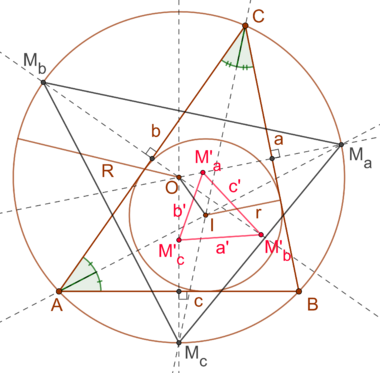Fuhrmann triangle
The Fuhrmann triangle, named after Wilhelm Fuhrmann (1833–1904), is special triangle based on a given arbitrary triangle.
For a given triangle [math]\displaystyle{ \triangle ABC }[/math] and its circumcircle the midpoints of the arcs over triangle sides are denoted by [math]\displaystyle{ M_a, M_b, M_c }[/math]. Those midpoints get reflected at the associated triangle sides yielding the points [math]\displaystyle{ M^\prime_a, M^\prime_b, M^\prime_c }[/math], which forms the Fuhrmann triangle.[1][2]
The circumcircle of Fuhrmann triangle is the Fuhrmann circle. Furthermore the Furhmann triangle is similar to the triangle formed by the mid arc points, that is [math]\displaystyle{ \triangle M^\prime_c M^\prime_b M^\prime_a \sim \triangle M_a M_b M_c }[/math].[1] For the area of the Fuhrmann triangle the following formula holds:[3]
- [math]\displaystyle{ |\triangle M^\prime_c M^\prime_b M^\prime_a| = \frac{(a+b+c)|OI|^2}{4R}=\frac{(a+b+c)(R-2r)}{4} }[/math]
Where [math]\displaystyle{ O }[/math] denotes the circumcenter of the given triangle [math]\displaystyle{ \triangle ABC }[/math] and [math]\displaystyle{ R }[/math] its radius as well as [math]\displaystyle{ I }[/math] denoting the incenter and [math]\displaystyle{ r }[/math] its radius. Due to Euler's theorem one also has [math]\displaystyle{ |OI|^2=R(R-2r) }[/math]. The following equations hold for the sides of the Fuhrmann triangle:[3]
- [math]\displaystyle{ a^\prime=\sqrt{\frac{(-a+b+c)(a+b+c)}{bc}}|OI| }[/math]
- [math]\displaystyle{ b^\prime=\sqrt{\frac{(a-b+c)(a+b+c)}{ac}}|OI| }[/math]
- [math]\displaystyle{ c^\prime=\sqrt{\frac{(a+b-c)(a+b+c)}{ab}}|OI| }[/math]
Where [math]\displaystyle{ a, b, c }[/math] denote the sides of the given triangle [math]\displaystyle{ \triangle ABC }[/math] and [math]\displaystyle{ a^\prime, b^\prime, c^\prime }[/math] the sides of the Fuhrmann triangle (see drawing).
References
- ↑ 1.0 1.1 Roger A. Johnson: Advanced Euclidean Geometry. Dover 2007, ISBN:978-0-486-46237-0, pp. 228–229, 300 (originally published 1929 with Houghton Mifflin Company (Boston) as Modern Geometry).
- ↑ Ross Honsberger: Episodes in Nineteenth and Twentieth Century Euclidean Geometry. MAA, 1995, pp. 49-52
- ↑ 3.0 3.1 Weisstein, Eric W.. "Fuhrmann triangle". http://mathworld.wolfram.com/FuhrmannTriangle.html. (retrieved 2019-11-12)



